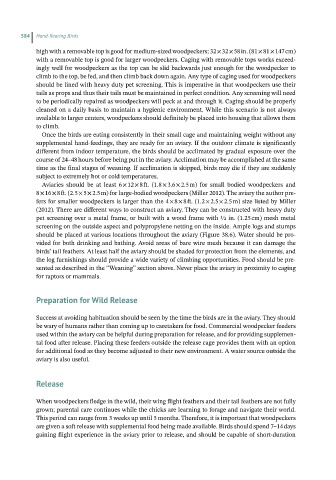Page 583 - Hand rearing birds second
P. 583
584 Hand-Rearing Birds
high with a removable top is good for medium‐sized woodpeckers; 32 × 32 × 58 in. (81 × 81 × 147 cm)
with a removable top is good for larger woodpeckers. Caging with removable tops works exceed-
ingly well for woodpeckers as the top can be slid backwards just enough for the woodpecker to
climb to the top, be fed, and then climb back down again. Any type of caging used for woodpeckers
should be lined with heavy duty pet screening. This is imperative in that woodpeckers use their
tails as props and thus their tails must be maintained in perfect condition. Any screening will need
to be periodically repaired as woodpeckers will peck at and through it. Caging should be properly
cleaned on a daily basis to maintain a hygienic environment. While this scenario is not always
available to larger centers, woodpeckers should definitely be placed into housing that allows them
to climb.
Once the birds are eating consistently in their small cage and maintaining weight without any
supplemental hand‐feedings, they are ready for an aviary. If the outdoor climate is significantly
different from indoor temperature, the birds should be acclimated by gradual exposure over the
course of 24–48 hours before being put in the aviary. Acclimation may be accomplished at the same
time as the final stages of weaning. If acclimation is skipped, birds may die if they are suddenly
subject to extremely hot or cold temperatures.
Aviaries should be at least 6 × 12 × 8 ft. (1.8 × 3.6 × 2.5 m) for small bodied woodpeckers and
8 × 16 × 8 ft. (2.5 × 5 × 2.5 m) for large‐bodied woodpeckers (Miller 2012). The aviary the author pre-
fers for smaller woodpeckers is larger than the 4 × 8 × 8 ft. (1.2 × 2.5 × 2.5 m) size listed by Miller
(2012). There are different ways to construct an aviary. They can be constructed with heavy duty
pet screening over a metal frame, or built with a wood frame with ½ in. (1.25 cm) mesh metal
screening on the outside aspect and polypropylene netting on the inside. Ample logs and stumps
should be placed at various locations throughout the aviary (Figure 38.6). Water should be pro-
vided for both drinking and bathing. Avoid areas of bare wire mesh because it can damage the
birds’ tail feathers. At least half the aviary should be shaded for protection from the elements, and
the log furnishings should provide a wide variety of climbing opportunities. Food should be pre-
sented as described in the “Weaning” section above. Never place the aviary in proximity to caging
for raptors or mammals.
Preparationfor WildRelease
Success at avoiding habituation should be seen by the time the birds are in the aviary. They should
be wary of humans rather than coming up to caretakers for food. Commercial woodpecker feeders
used within the aviary can be helpful during preparation for release, and for providing supplemen-
tal food after release. Placing these feeders outside the release cage provides them with an option
for additional food as they become adjusted to their new environment. A water source outside the
aviary is also useful.
Release
When woodpeckers fledge in the wild, their wing flight feathers and their tail feathers are not fully
grown; parental care continues while the chicks are learning to forage and navigate their world.
This period can range from 3 weeks up until 5 months. Therefore, it is important that woodpeckers
are given a soft release with supplemental food being made available. Birds should spend 7–14 days
gaining flight experience in the aviary prior to release, and should be capable of short‐duration

